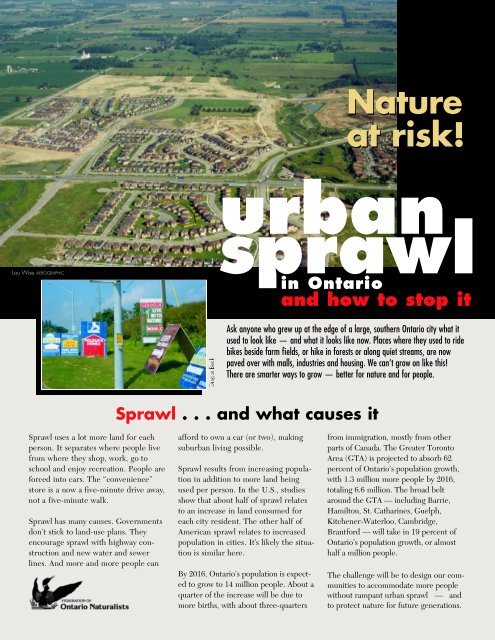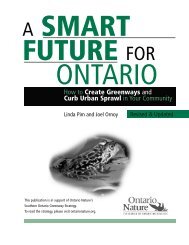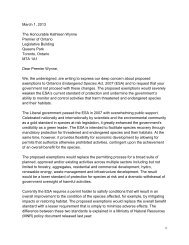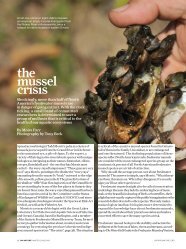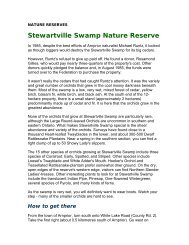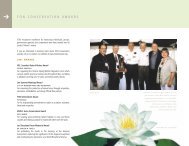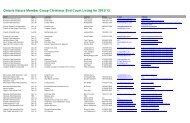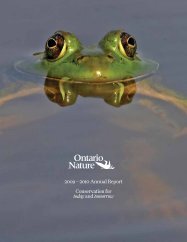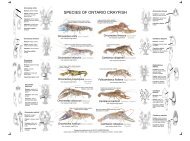Urban Sprawl - Ontario Nature
Urban Sprawl - Ontario Nature
Urban Sprawl - Ontario Nature
Create successful ePaper yourself
Turn your PDF publications into a flip-book with our unique Google optimized e-Paper software.
N a t u r e<br />
at risk!<br />
Lou Wise AEROGRAPHIC<br />
urban<br />
sprawl<br />
in <strong>Ontario</strong><br />
and how to stop it<br />
Ask anyone who grew up at the edge of a large, southern <strong>Ontario</strong> city what it<br />
used to look like — and what it looks like now. Places where they used to ride<br />
bikes beside farm fields, or hike in forests or along quiet streams, are now<br />
paved over with malls, industries and housing. We can’t grow on like this!<br />
There are smarter ways to grow — better for nature and for people.<br />
<strong>Sprawl</strong> . . . and what causes it<br />
<strong>Sprawl</strong> uses a lot more land for each<br />
person. It separates where people live<br />
from where they shop, work, go to<br />
school and enjoy recreation. People are<br />
forced into cars. The “convenience”<br />
store is a now a five-minute drive away,<br />
not a five-minute walk.<br />
<strong>Sprawl</strong> has many causes. Governments<br />
d o n ’t stick to land-use plans. They<br />
encourage sprawl with highway construction<br />
and new water and sewer<br />
lines. And more and more people can<br />
afford to own a car (or two), making<br />
suburban living possible.<br />
<strong>Sprawl</strong> results from increasing population<br />
in addition to more land being<br />
used per person. In the U.S., studies<br />
show that about half of sprawl relates<br />
to an increase in land consumed for<br />
each city resident. The other half of<br />
American sprawl relates to increased<br />
population in cities. It’s likely the situation<br />
is similar here.<br />
By 2016, <strong>Ontario</strong>’s population is expected<br />
to grow to 14 million people. About a<br />
quarter of the increase will be due to<br />
more births, with about three-quarters<br />
from immigration, mostly from other<br />
parts of Canada. The Greater Toronto<br />
Area (GTA) is projected to absorb 62<br />
percent of <strong>Ontario</strong>’s population growth,<br />
with 1.3 million more people by 2016,<br />
totaling 6.6 million. The broad belt<br />
around the GTA — including Barrie,<br />
Hamilton, St. Catharines, Guelph,<br />
Kitchener-Waterloo, Cambridge,<br />
Brantford — will take in 19 percent of<br />
<strong>Ontario</strong>’s population growth, or almost<br />
half a million people.<br />
The challenge will be to design our communities<br />
to accommodate more people<br />
without rampant urban sprawl — and<br />
to protect nature for future generations.
<strong>Sprawl</strong> is bad for nature<br />
<strong>Sprawl</strong> destroys wildlife habitat. Forests, wetlands, meadows<br />
and valleys are cut, bulldozed, filled in and paved<br />
over to make room for urban<br />
expansion. Farmland is destroyed,<br />
too, so food can’t be grown near<br />
cities. Paving over farms and natural<br />
areas disrupts the delicate<br />
water balance among rain and<br />
snow, groundwater aquifers, and<br />
rivers and streams. New roads<br />
slice through scarce natural habitats,<br />
threatening populations of<br />
forest-interior birds such as scarlet tanager and ovenbird<br />
that require large woodlands.<br />
<strong>Sprawl</strong> causes water and air pollution. Laden with contaminants<br />
such as oil, pesticides and road salt, water after<br />
storms is channeled through pipes into nearby waterways.<br />
Car dependence over transit and increased use of truck<br />
freight over rail are causing traffic gridlock on our highways<br />
and smog choking our lungs. Air pollution causes<br />
nearly 2,000 premature deaths in <strong>Ontario</strong> each year.<br />
Gridlock is not only bad for our health, it’s bad for our<br />
economy too: Traffic congestion in the GTA and<br />
Hamilton areas already costs $2 billion a year from delays<br />
in truck deliveries.<br />
Gregor Beck<br />
Queen’s Park policies allow sprawl<br />
The current <strong>Ontario</strong> government has failed to ensure orderly and cost-effective growth. Instead,<br />
the province has required municipalities, counties and regions to expand urban areas often<br />
without considering negative impacts on land and nature.<br />
The tax system supports sprawl: The 1996 provincial budget gave a rebate to first-time buyers<br />
who choose a newly-constructed home (usually in sprawl areas). The $2,000 rebate is now a<br />
fixture.<br />
Further, the province’s $20 billion SuperBuild Growth Fund, which helps pay infrastructure costs<br />
such as highways and sewers, doesn’t support public transit.<br />
Curbing sprawl with “smart growth”<br />
Attempts to curb sprawl aren’t new.<br />
Plans to contain Toronto — to keep<br />
the city urban and the countryside<br />
rural — were conceived as early as<br />
the 1950s.<br />
We have to stop extending highways,<br />
sewer systems and water pipes out into<br />
the countryside in anticipation of possible<br />
but as-yet unplanned urban growth.<br />
For example, there wouldn’t have been<br />
as much sprawl on the Oak Ridges<br />
Moraine during the past decade if it<br />
w e r e n ’t for construction of the Yo r k -<br />
Durham Sewer System. We first need<br />
to decide where it’s best to have urban<br />
growth — where it can happen with<br />
the least destruction of forests, wetlands<br />
and farmland, and the least pollution<br />
of our air and water. Only after<br />
that has been done is it necessary<br />
to figure out road and sewer systems,<br />
as part of the overall planning for our<br />
c o m m u n i t i e s .
W h a t ’s new about curbing sprawl<br />
is the name — smart growth.<br />
The term was coined in the United<br />
States a few years ago to describe a mix<br />
of alternatives to “problem growth.”<br />
Smart growth assumes that cities will<br />
g r o w, and embraces a number of attractive<br />
features:<br />
Conserves important natural areas<br />
and farmland by maintaining clear<br />
urban boundaries.<br />
Provides incentives for existing communities<br />
to grow where public utilities<br />
such as sewers and water pipes<br />
already exist. This includes reclaiming<br />
older buildings and re-developing<br />
abandoned industrial lands<br />
(“brownfields”).<br />
Creates vibrant, pedestrian-friendly<br />
communities with a range of housing<br />
types and costs.<br />
Provides alternatives to cars such as<br />
convenient, efficient public transit,<br />
with development located near existing<br />
transit routes.<br />
Fully involves citizens in helping<br />
design their communities’ future.<br />
Collaborations and public-private<br />
partnerships are keys to smartgrowth<br />
success.<br />
Growing bigger and better<br />
Smart Growth is Working!<br />
Linda Pim<br />
The City of Toronto can’t grow any wider around the edges — its boundaries are fixed.<br />
Although the city is forecast to grow by about half a million people over the next 30 years, city<br />
planners recently proposed that Toronto could help curb sprawl by welcoming more growth in<br />
compact, livable urban renewal projects. Toronto could thereby accommodate one million more<br />
residents. One example is shown above — attractive, new row housing on reclaimed industrial<br />
land just steps from a downtown streetcar line.<br />
Oregon started to rein in sprawl almost 30 years ago. As a result of laws passed in<br />
1973, each of Oregon’s 240 cities is surrounded by an urban growth boundary<br />
(UGB), which shows where a city expects to grow. <strong>Urban</strong> services such as sewers<br />
won’t be extended beyond the UGB and zoning outside it prohibits urban<br />
densities. A UGB can be modified — and some have been — but only if the<br />
city complies with statewide planning goals and standards for UGBs.<br />
Maryland has taken a different tack. Since 1997, they’ve opted for an incentives-based<br />
rather than legislated approach by subsidizing economic development<br />
only in Priority Growth Areas. Success depends on cooperation of county<br />
governments, so while counties have the final say on where growth areas will<br />
be, the state won’t put up funding if its smart-growth criteria aren’t met. The<br />
state encourages re-development of abandoned industrial lands and promotes<br />
its ‘Live Near Your Work’ program by providing cash incentives for homebuyers<br />
to purchase near their employment.<br />
Smart Growth on the Web<br />
Canada<br />
Canadian <strong>Urban</strong> Institute<br />
SmartGrowthBC<br />
U.S.A.<br />
Smart Growth Network<br />
Smart Growth America<br />
<strong>Sprawl</strong> Watch Clearinghouse<br />
Sierra Club Challenge to <strong>Sprawl</strong><br />
www.canurb.com<br />
www.smartgrowth.bc.ca<br />
www.smartgrowth.org<br />
www.smartgrowthamerica.com<br />
www.sprawlwatch.org<br />
www.sierraclub.org/sprawl/<br />
Gregor Beck
Made-in-<strong>Ontario</strong><br />
Smart Growth<br />
The <strong>Ontario</strong> government should<br />
implement a mix of actions to<br />
plan urban growth. These could<br />
include:<br />
improving urban growth restrictions<br />
and natural heritage protections of<br />
the Provincial Policy Statement<br />
under the Planning Act.<br />
requiring municipalities to do<br />
land-use planning consistent with<br />
provincial policies.<br />
in collaboration with municipalities,<br />
setting fixed urban growth boundaries<br />
so that prime farmlands and<br />
natural areas are protected for the<br />
future. A good place to start would<br />
be the fast-growing cities on and<br />
near the Oak Ridges Moraine, as<br />
well as Barrie, Kitchener-Waterloo,<br />
Guelph and the “Golden Horseshoe.”<br />
using the Maryland model of directing<br />
infrastructure subsidies only to<br />
areas practising smart planning.<br />
restoring provincial funding to public<br />
transit and promoting integrated<br />
regional transit services.<br />
fostering dialogue among citizens,<br />
planners, municipal councillors,<br />
boards of trade, developers and others<br />
to determine what smart growth<br />
features suit each community.<br />
encouraging Ottawa to partner with<br />
provincial and municipal governments<br />
by flowing housing and transit<br />
dollars to smart-growth strategies.<br />
A word of warning:<br />
Beware of those using the term “smart<br />
growth” to justify any urban initiative.<br />
When public money becomes available<br />
for anti-sprawl projects, there’s a great<br />
temptation to call all growth “smart.”<br />
Make sure the “smart” project or activity<br />
really is, by evaluating it against the<br />
checklist above.<br />
Smart Growth<br />
Action Plan<br />
What you can<br />
do to protect<br />
nature from<br />
urban sprawl<br />
If you agree that the provincial government<br />
must guarantee future generations<br />
clean air, clean water, woodlands,<br />
wetlands and a diversity of wildlife,<br />
then please send an action letter to<br />
Premier Mike Harris. Tell him you<br />
expect a guarantee! Your action letter<br />
will support FON’s campaign for<br />
provincial land-use planning controls<br />
that will protect nature from urban<br />
sprawl. Please urge Premier Harris to:<br />
“green” the land-use planning system<br />
to that it permanently protects<br />
natural areas and farmlands outside<br />
well-defined urban boundaries<br />
restore provincial funding for public<br />
transit, and<br />
provide incentives for municipalities<br />
who want to grow smarter by<br />
accommodating new growth within<br />
existing urban boundaries<br />
Write him today!<br />
Premier Mike Harris,<br />
Legislative Building, Queen’s Park,<br />
Toronto, <strong>Ontario</strong> M7A 1A1,<br />
fax 416-325-7578,<br />
email webprem@gov.on.ca<br />
Or call him at 416-325-1941.<br />
You can also send an action letter to:<br />
The Honourable Chris Hodgson,<br />
Minister of Municipal Affairs and Housing<br />
777 Bay Street, 17th Floor,<br />
Toronto, <strong>Ontario</strong> M5G 2E5,<br />
fax (416) 585-6470,<br />
email mininfo@mah.gov.on.ca<br />
Or call him at 416-585-7000.<br />
Encourage your municipal council to<br />
plan for smart growth. If your council<br />
doesn’t have an environmental advisory<br />
committee (EAC) of local citizens, ask<br />
for one to be established (for details,<br />
see FON’s website).<br />
Contact FON for more information on<br />
smart growth — and starting a smartgrowth<br />
group in your community.<br />
Embrace smart growth in your daily<br />
life by trying to live near your workplace,<br />
choose a home convenient to<br />
public transit, and support businesses<br />
in your own neighbourhood.<br />
Your voice counts!<br />
Don’t forget to send a copy of your letter<br />
to the Federation of <strong>Ontario</strong><br />
Naturalists. We want to deliver the<br />
message to Premier Harris that thousands<br />
of Ontarians from across the<br />
province want provincial leadership to<br />
curb sprawl.<br />
Join Today!<br />
Connect to nature<br />
through membership<br />
in the Federation of<br />
<strong>Ontario</strong> Naturalists.<br />
On-line at<br />
www.ontarionature.org<br />
or call 416-444-8419<br />
1-800-440-2366<br />
The Federation of <strong>Ontario</strong> Naturalists<br />
(FON) protects <strong>Ontario</strong>’s nature through<br />
research, education, and conservation<br />
action. FON champions woodlands, wetlands<br />
and wildlife, and preserves essential<br />
habitat through its own system of nature<br />
reserves. FON is a conservation organization<br />
representing 15,000 members and<br />
over 110 member groups across <strong>Ontario</strong>.<br />
355 Lesmill Road, Don Mills, ON M3B 2W8<br />
Tel: 416-444-8419<br />
Fax: 4160444-9866<br />
E-mail: info@ontarionature.org<br />
Website: www.ontarionature.org<br />
Summer 2001


